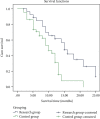The Evaluation of Clinical Status of Endoscopic Retrograde Cholangiography for the Placement of Metal and Plastic Stents in Cholangiocarcinoma Therapy
- PMID: 36267306
- PMCID: PMC9578868
- DOI: 10.1155/2022/5741437
The Evaluation of Clinical Status of Endoscopic Retrograde Cholangiography for the Placement of Metal and Plastic Stents in Cholangiocarcinoma Therapy
Abstract
Objective: Cholangiocarcinoma is a common malignant tumor that occurs in the bile duct system, which can be treated by using the endoscopic retrograde cholangiography (ERCP). This study was aimed at exploring the therapeutic effect of ERCP with metal stent and plastic stent for cholangiocarcinoma.
Methods: The clinical data of 71 patients with cholangiocarcinoma treated by ERCP in our hospital from June 2020 to October 2021 were retrospectively analyzed. According to different stent types, the patients were divided into plastic stent group (n = 43) and metal stent group (n = 28). Patients in the plastic stent group and metal stent group were received with plastic stent and metal stent, respectively. The indexes of liver function (serum alkaline phosphatase (ALT), direct bilirubin (DBIL), glutamic oxaloacetic transaminase (AST), alkaline phosphatase (ALP), and total bilirubin (TBIL)), postoperative complications, success rate of stent implantation, and survival time of patients in the two groups were determined. Logistic multivariate regression analysis was used to analyze the prognostic factors of postoperative cholangiocarcinoma.
Results: The liver function indexes of the two groups were significantly improved after treatment with the stent, in which the ameliorative effect in the metal stent group was better than that in the plastic stent group (P < 0.05). The incidence of postoperative complications in the plastic stent group and the metal stent group was 53.49% and 14.29%, respectively, and the success rate of stent placement was 60.47% and 96.43%, respectively. The incidence of complications in the metal stent group was lower than that in the plastic stent group, and the success rate of stent placement was higher than that in the plastic stent group (P < 0.05). The median survival time of patients in the plastic stent group and the metal stent group was 8.15 and 11.83 months, respectively. The survival time of patients in the metal stent group was longer than that of the plastic stent group. The median survival time of patients with types I, II, III, and IV was 12.73, 11.54, 10.57, and 9.36 months, respectively. The survival time of patients with stage I was significantly higher than that of patients with types II, III, and IV. There was an inverse relationship between the disease type and the survival time of patients. Logistic multivariate regression analysis showed that tumor diameter ≥ 5 cm, portal vein invasion, lymph node metastasis, and classification of hilar cholangiocarcinoma were the risk factors (P < 0.05) and metal stent type was the protective factor (P < 0.05).
Conclusion: In the clinical treatment of patients with cholangiocarcinoma, the placement of metal stent and plastic stent under ERCP plays an important role. The placement of the metal stent under ERCP has a higher success rate and better prognosis and can prolong the survival time of patients to a greater extent, but the price of the metal stent is relatively expensive. For patients with an expected survival period of more than 4-6 months, the metal stent should be considered; otherwise, the plastic stent can be used to maintain cost-effectiveness. Therefore, it is necessary to comprehensively analyze the patient's economic affordability, expected survival time, stent drainage time, and personal needs and then select an appropriate treatment method.
Copyright © 2022 Min Gong et al.
Conflict of interest statement
The author(s) declare(s) that they have no conflicts of interest.
Figures



Similar articles
-
Endoscopic stenting for hilar cholangiocarcinoma: efficacy of unilateral and bilateral placement of plastic and metal stents in a retrospective review of 480 patients.BMC Gastroenterol. 2012 Aug 9;12:103. doi: 10.1186/1471-230X-12-103. BMC Gastroenterol. 2012. PMID: 22873816 Free PMC article.
-
Clinical outcome in patients with hilar malignant strictures type II Bismuth-Corlette treated by minimally invasive unilateral versus bilateral endoscopic biliary drainage.Hepatobiliary Pancreat Dis Int. 2012 Apr;11(2):209-14. doi: 10.1016/s1499-3872(12)60150-7. Hepatobiliary Pancreat Dis Int. 2012. PMID: 22484591
-
Percutaneous transhepatic cholangiography and drainage and endoscopic retrograde cholangiopancreatograph for hilar cholangiocarcinoma: which one is preferred?Rev Esp Enferm Dig. 2020 Dec;112(12):893-897. doi: 10.17235/reed.2020.6937/2020. Rev Esp Enferm Dig. 2020. PMID: 33118356
-
Endoscopic retrograde cholangiopancreatography for cholangiocarcinoma.Clin Liver Dis. 2014 Nov;18(4):891-7. doi: 10.1016/j.cld.2014.07.008. Epub 2014 Aug 28. Clin Liver Dis. 2014. PMID: 25438289 Review.
-
[Treatment of malignant and benign biliary obstructions with metal stents].Rofo. 2000 Apr;172(4):315-22. doi: 10.1055/s-2000-329. Rofo. 2000. PMID: 10961214 Review. German.
Cited by
-
Endoscopic treatment of unresectable perihilar cholangiocarcinoma: beyond biliary drainage.Therap Adv Gastroenterol. 2025 Apr 14;18:17562848251328595. doi: 10.1177/17562848251328595. eCollection 2025. Therap Adv Gastroenterol. 2025. PMID: 40292090 Free PMC article. Review.
-
Development and application of an early warning model for predicting early mortality following stent placement in malignant biliary obstruction: A comparative analysis of logistic regression and artificial neural network approaches.Oncol Lett. 2025 Mar 20;29(5):237. doi: 10.3892/ol.2025.14983. eCollection 2025 May. Oncol Lett. 2025. PMID: 40166368 Free PMC article.
-
Endoscopic Treatment of Malignant Hilar Biliary Obstruction.Cancers (Basel). 2023 Dec 13;15(24):5819. doi: 10.3390/cancers15245819. Cancers (Basel). 2023. PMID: 38136363 Free PMC article. Review.
References
MeSH terms
Substances
LinkOut - more resources
Full Text Sources
Medical

